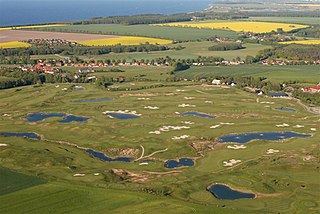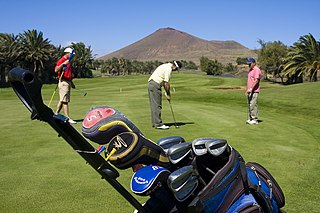
A sand wedge, or sand iron, is a type of golf club, an open-faced wedge primarily designed for getting out of sand bunkers. It has the widest sole of any wedge, which provides the greatest amount of bounce, allowing the club head to glide through sand and avoid digging in. After Gene Sarazen had success in 1932 with a new club that he had invented for sand play, its popularity quickly grew. The club can be advantageous in other soft lies—such as thick rough, soggy ground, or mud—and is also used from firmer grass lies for lobs or chips.

A golf course is the grounds on which the sport of golf is played. It consists of a series of holes, each consisting of a tee box, a fairway, the rough and other hazards, and a green with a cylindrical hole in the ground, known as a "cup". The cup holds a flagstick, known as a "pin". A standard round of golf consists of 18 holes, and as such most courses contain 18 distinct holes; however, there are many 9-hole courses and some that have holes with shared fairways or greens. There are also courses with a non-standard number of holes, such as 12 or 14.
A golf club is a club used to hit a golf ball in a game of golf. Each club is composed of a shaft with a grip and a club head. Woods are mainly used for long-distance fairway or tee shots; irons, the most versatile class, are used for a variety of shots; hybrids that combine design elements of woods and irons are becoming increasingly popular; putters are used mainly on the green to roll the ball into the hole. A set of clubs is limited by the rules of golf to a maximum of 14 golf clubs, and while there are traditional combinations sold at retail as matched sets, players are free to use any combination of legal clubs.

A golf ball is a special ball designed to be used in the game of golf.
The following is a glossary of the terminology currently used in the sport of golf. Where words in a sentence are also defined elsewhere in this article, they appear in italics. Old names for clubs can be found at Obsolete golf clubs.

In the sport of golf, a wedge is a subset of the iron family of golf clubs designed for special use situations. As a class, wedges have the highest lofts, the shortest shafts, and the heaviest clubheads of the irons. These features generally aid the player in making accurate short-distance "lob" shots, to get the ball onto the green or out of a hazard or other tricky spot. In addition, wedges are designed with modified soles that aid the player in moving the clubhead through soft lies, such as sand, mud, and thick grass, to extract a ball that is embedded or even buried. Wedges come in a variety of configurations, and are generally grouped into four categories: pitching wedges, sand wedges, gap/approach wedges and lob wedges.
In golf, a gap wedge, also known as an approach wedge, is a wedge used to hit a shot with higher and shorter trajectory than a pitching wedge and lower and longer trajectory than a sand wedge. The name derives from the club's design to fill the "gap" between sand and pitching wedges.
A pitching wedge is a wedge used to hit a shot with higher and shorter trajectory than a 9-iron and a lower and longer trajectory than a gap wedge.

A hazard is an area of a golf course in the sport of golf which provides a difficult obstacle, which may be of two types: (1) water hazards such as lakes and rivers; and (2) man-made hazards such as bunkers. The governing body for the game of golf outside the US and Canada, The R&A, say that A "hazard" is any bunker or water hazard. Special rules apply to play balls that fall in a hazard. For example, a player may not touch the ground with their club before playing a ball, not even for a practice swing. A ball in any hazard may be played as it lies without penalty. If it cannot be played from the hazard, the ball may be hit from another location, generally with a penalty of one stroke. The Rules of Golf govern exactly from where the ball may be played outside a hazard. Bunkers are shallow pits filled with sand and generally incorporating a raised lip or barrier, from which the ball is more difficult to play than from grass.
The shaft of a golf club is the long, tapered tube which connects the golfer's hands to the club head. While hundreds of different designs exist, the primary purpose of the golf shaft remains the same: to provide the player with a way to generate centrifugal force in order to effectively strike the ball. When properly gripped the player can hit the ball further and more accurately, whilst applying less force.

Golf equipment encompasses the various items that are used to play the sport of golf. Types of equipment include the golf ball, golf clubs, and devices that aid in the sport.
In the sport of golf, a penalty or penalty stroke is an additional stroke or strokes added to a player's score for an infraction of the rules. In match play, rather than adding strokes, the usual penalty is loss of the hole except for penalties assessed for relief from a hazard or a lost ball.

A wood is a type of club used in the sport of golf. Woods have longer shafts and larger, rounder heads than other club types, and are used to hit the ball longer distances than other types.

An iron is a type of club used in the sport of golf to propel the ball towards the hole. Irons typically have shorter shafts and smaller clubheads than woods, the head is made of solid iron or steel, and the head's primary feature is a large, flat, angled face, usually scored with grooves. Irons are used in a wide variety of situations, typically from the teeing ground on shorter holes, from the fairway or rough as the player approaches the green, and to extract the ball from hazards, such as bunkers or even shallow water hazards.

A putter is a club used in the sport of golf to make relatively short and low-speed strokes with the intention of rolling the ball into the hole from a short distance away. It is differentiated from the other clubs by a clubhead with a very flat, low-profile, low-loft striking face, and by other features which are only allowed on putters, such as bent shafts, non-circular grips, and positional guides.

John Erickson is an American professional golfer who played the Canadian Tour from 1987 to 1994 and the PGA Tour of Australasia Tour from 1987 to 1992.

Brassie is the old traditional name for a wood No. 2 golf club. Brassies have a loft that is higher than that of a driver, but less than a 3 wood.

Golf is a club-and-ball sport in which players use various clubs to hit a ball into a series of holes on a course in as few strokes as possible.

The golf swing is the action by which players hit the ball in the sport of golf. The golf swing is a complex motion involving the whole body; the technicalities of the swing are known as golf stroke mechanics.
A lob wedge, also known as a lofted wedge or an L-Wedge, is a wedge used in the sport of golf, known for being one of the shortest-hitting clubs and providing the most loft on a shot. Lob wedges are used to produce shots with a very high arc, and are most often used for shots over hazards and other obstructions. Due to the high arc of the shot the lob wedge, like the other wedges in the set of irons, produces little roll after landing on the putting green and can even be used to produce backspin if necessary. Lob wedges are one of the newest additions to the modern collection of golf clubs and, along with the sand wedge and gap wedge, were not included prior to 1931.













